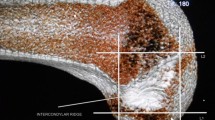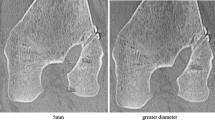Abstract
The aim of this anatomic descriptive cadaver study is to evaluate the entrance points of cross-pins and the possible chondral damages, using a two cross-pin femoral fixation device via anteromedial portal, during anterior cruciate ligament (ACL) reconstruction. Twenty fresh-frozen cadaver knees (12 cadavers) were tested. We employed the Rigidfix Cross Pin device (Mitek, Norwood, MA), designed to use two biodegradable pins (PLA, length 42 mm, diameter 2.7 mm). Instead of PLA pins, we used color coded metallic pins. Femoral tunnel drilling and cross-pin guide insertions were performed through the anteromedial portal. We gave three positions to the cross-pin guide: 0°, 45° and 90° slope, referring to the horizontal plane. Per each position, we inserted two metallic pins. We recorded and subdivided the pin holes, in three different groups: Group A (0°); B (45°); C (90° of slope). Then a wide dissection has been implemented. Group A: 6 knees (30%) had two pins inside the cartilage of the lateral femoral condyle; 10 knees (50%) had one pin inside the cartilage; and 4 knees (20%) had both pins out of the cartilage. Group B: 7 knees (35%) had two pins inside the cartilage; 12 knees (60%) had one pin inside the cartilage; and one knee (5%) had both pins out of the cartilage. Group C: 7 knees (35%) had two pins inside the cartilage; and 13 knees (65%) had one pin inside the cartilage. The risk of chondral injury, using this technique, is high: from 80% (group A) to 100% (Group C) to have at least one pin inside the cartilage. The use of Rigidfix via AM portal is not recommended for routine ACL reconstruction.




Similar content being viewed by others
References
Becker R, Voigt D, Stärke C, Heymann M, Wilson GA, Nebelung W (2001) Biomechanical properties of quadruple tendon and patellar tendon femoral fixation techniques. Knee Surg Sports Traumatol Arthrosc 9:337–342
Frank CB, Jackson DW (1997) The science of reconstruction of anterior cruciate ligament. Current concepts review. J Bone Joint Surg Am 79:1556–1576
Hardin GT, Bach BR Jr, Bush-Joseph CA, Farr J (2003) Endoscopic single-incision anterior cruciate ligament reconstruction using patellar tendon autograft. J Knee Surg 16:135–144
Mahirogullari M, Oguz Y, Ozkan H (2006) Reconstruction of the anterior cruciate ligament using bone-patellar tendon-bone graft with double biodegradable femoral pin fixation. Knee Surg Sports Traumatol Arthrosc 14:646–653
Warnock M, Elkousy H (2004) Recent issues in anterior cruciate ligament surgery. Curr Opin Ortho 15:86–91
Ahmad CS, Gardner TR, Groh M, Arnouk J, Levine WN (2004) Mechanical properties of soft tissue femoral fixation devices for anterior cruciate ligament reconstruction. Am J Sports Med 32:635–640
Morgan CD, Kalman VR, Grawl DM (1995) Isometry testing for anterior cruciate ligament reconstruction revisited. Arthroscopy 11:647–659
Hantes ME, Dailiana Z, Zachos V, Varitimidis SE (2006) Anterior cruciate ligament reconstruction using the Bio-TransFix femoral fixation device and anteromedial portal technique. Knee Surg Sports Traumatol Arthrosc 14:497–501
Kousa P, Jarvinen TL, Vihavainen M, Kannus P, Jarvinen M (2003) The fixation strength of six hamstring tendon graft fixation devices in anterior cruciate ligament reconstruction- part 1: femoral site. Am J Sports Med 31:174–181
Zantop T, Welbers B, Weimann A, et al (2004) Biomechanical evaluation of a new cross-pin technique for the fixation of different sized bone-patellar tendon-bone grafts. Knee Surg Sports Traumatol Arthrosc 12:520–527 http://www.springerlink.metapress.com
Salini V, Colucci C, Palmieri D (2005) Artroscopia di ginocchio: principi generali della tecnica. In: Pellacci F (ed) Chirurgia artroscopica dell’arto inferiore Mattioli 1885
Clark R, Olsen RE, Larson BJ, Goble EM, Farrer RP (1998) Cross-pin femoral fixation: a new technique for hamstring anterior cruciate ligament reconstruction of the knee. Arthroscopy 14(3):258–267
Author information
Authors and Affiliations
Corresponding author
Rights and permissions
About this article
Cite this article
Castoldi, F., Bonasia, D.E., Marmotti, A. et al. ACL reconstruction using the Rigidfix femoral fixation device via the anteromedial portal: a cadaver study to evaluate chondral injuries. Knee Surg Sports Traumatol Arthr 16, 275–278 (2008). https://doi.org/10.1007/s00167-007-0459-9
Received:
Accepted:
Published:
Issue Date:
DOI: https://doi.org/10.1007/s00167-007-0459-9




